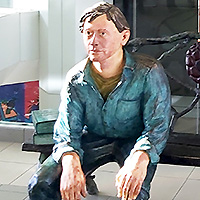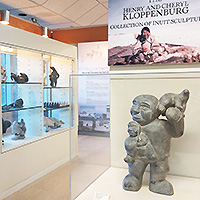Self-Guided Art Tour
College of Agriculture and Bioresources self-guided art tour through the Agriculture Building.
Background
When the Agriculture Building was opened in 1991, $250,000 was reserved from the building fund to establish an art collection. The funded collection was primarily acquired during the 1990s under the direction of the college’s art committee and is almost exclusively comprised of works by Saskatchewan artists. Since then, the college’s art collection has been augmented through numerous donations. This self-guided tour spotlights some of the purchased and donated art found throughout the college’s halls.
The Beamish Conservatory (main floor) and Kenderdine gallery (second floor) were conceived during the design phase of the building and came to be as the result of several very generous gifts from May Beamish. The Kenderdine Gallery was a legacy to her father, Gus Kenderdine (1870-1947). Mr. Kenderdine immigrated to Canada in 1908. He had previously studied art in Manchester and, later, France. In 1926, he became the university’s first art instructor and played a pivotal role in shaping Saskatchewan’s art community. Among his numerous achievements, he established the Murray Point Art School at Emma Lake in 1936.
Tour start – main floor atrium at painted blanket in kiosk.
The painting Elk Whistles, Jingle Dresses and Ribbon Shirts was created by Prince Albert artist Bob Boyer. Mr. Boyer (1948-2004) was a painter, installation artist, powwow dancer, social activist, educator, and author. Through trips to Asia he was inspired to paint on cloth but chose blankets for the work that he became most recognized. During colonization, First Nations people associated wool blankets with sources of disease. These blanket paintings became known as the “blanket statements” because they symbolized the colonial influences on First Nations people and the land.
Proceed to 2nd floor to top of stairway and the boy on bench.

This sculpture, named Garden of the Mind, is cast in bronze and coloured using patina and acrylic paint. The artist, Victor Cicanski, cast the piece in Joe Fafard’s foundry at Pense, SK. Part of the college’s purchased collection, it is a beautiful example of functional art. Regularly used as a bench, it is almost certainly the most visited artwork in the college and is frequently photographed — often with the human subject clutching the bronze boy. In winter, lost toques regularly find their way to the boy’s head, who incidentally, was modelled after the artist’s son.
Proceed past the cafeteria to the Inuit Art Collection.

The extensive collection of Inuit carvings and sculptures was donated as a group by Henry and Cheryl Kloppenburg. The pieces reflect the connection of the Inuit artists’ to their environment. Local materials such as bone, soap stone, ivory, sinew and tusk have been transformed into artic wildlife and depictions of life in the far north.
Return to second floor atrium past the Garden of the Mind sculpture to the Joe Fafard cow in the display case opposite the Kenderdine Gallery.

Joe Fafard (1942-2019) was a nationally and internationally acclaimed artist with deep roots in Saskatchewan. His works are collected and displayed across Canada and around the globe. Never stagnating in his achievements, he made a point of experimenting with techniques and materials. Early sculptures were clay but in 1985 he shifted to bronze and constructed a foundry in Pense, SK to support this new direction. His subjects, often wildlife, farm animals and portraits were depicted with insight and whimsy. He was perhaps most well-known for his cow sculptures and this one is a fine example of his artistry.
Proceed to the elevator and travel to the 6th Floor.
Exit right from the elevator and go to Highland Cattle.
Highland Cattle Painting by William Smellie Watson

Supposedly painted in 1872, this piece’s history is cloaked in mystery. William Smellie Watson (1796-1874) was a Scottish painter and the highland cattle depicted in this painting might seem to be an appropriate choice for a Scot, except for the fact that like his father before him, he was known to be exclusively a portrait artist. Could this piece be a fake? Or a priceless rarity? Who knows? We do know the painting was a gift from Prof. A.H. Ewan to the college back in 1930 and was originally housed in the large first floor classroom in Kirk Hall.
Continue left, past the Highland Cattle to the next cattle painting.
Sales Ring by Gregor (McGregor) Hone

Like the highland cattle behind you this painting is also inspired by cattle, but the subject matter (a cattle auction ring) is presented in a cubist style. Mr. Hone taught art and painting in Regina for his entire life. As an instructor, he practiced many techniques, and the sixth floor contains numerous examples showing the breadth of his work.
Continue down the hall to the Kloppenburg Collection.
When you come to the inner hallway, you’ve arrived at the Kloppenburg Collection, also donated by Henry and Cheryl Kloppenburg. On your left, you’ll find 12 Robert Hurley paintings and, on the opposing wall, an assemblage of Allen Sapp paintings — believed to be one of the largest public collections of Sapp’s work outside of the Allen Sapp gallery.
Both artists are nationally recognized and their works are widely collected. Although, it could be argued that Sapp achieved wider critical acclaim than Hurley, but perhaps less monetary success.

Robert Hurley (1894-1980), born in England, became interested in art in his teens, regularly visiting London’s many galleries. He settled in Canada in his late 20s. He was largely self-taught but did receive some training from Ernest Lindner in the 1930s. He was a labourer for most of his working life but practiced watercolour painting at every opportunity. During the depression of the 1930s, when money and materials were scarce, he’d resorted to working with dyes from berries and using toothbrushes to hone his skills. He began to exhibit his work in the 1930s, and as his stature as an artist rose, was shown in increasingly more prestigious galleries (including the National Gallery in Ottawa during the 1970s). Hurley was a very prolific painter, never stopping until his death at which point it’s believed he had produced approximately 7,800 paintings.

Allen Sapp (1928-2015) was born on the Red Pheasant Cree Nation where, following the death of his mother from tuberculosis, was raised by his grandparents. Like Hurley, Sapp was drawn to art at a young age. A sickly child, he spent much of his time at home where his grandmother encouraged his artistic interests. He cared for her until she passed away in 1963, then moved to North Battleford with hopes of pursuing a career as an artist. He tried selling paintings door-to-door with limited success, but these efforts led him to meet a local physician and art enthusiast named Dr. Allan Gonor. Dr. Gonor recognized Sapp’s talent and encouraged him to paint from his memories of life on reserve. He also arranged for Sapp to be tutored by Wynona Mulcaster. With this personalized subject matter and more refined artistic acumen, Sapp’s esteem as an artist grew as did public interest in his work. His paintings are widely sought after and have been shown across the globe. He was elected to the Royal Academy of Arts in 1975, honoured with the Saskatchewan Order of Merit in 1985 and awarded the Order of Canada in 1986.
Proceeding into the Kloppenburg Collection corridor, compare the artists’ works taking note of the different media used — watercolour for Hurley and oil for Sapp. The two artists offer very different perspectives of prairie life. Hurley’s paintings have a precision not often seen with watercolour pieces and focus on wide open prairie landscapes. Sapp’s works are more up-close and intimate, sharing a glimpse into his history, community and life on reserve.
Time permitting, wander the outer halls of the sixth floor.
Exploring the sixth floor, you’ll find many other works from artists mentioned in this guide, including those of Ernest Lindner, Wynona Mulcaster, and Gregor Hone, as well as a number of other important artists who have shaped Saskatchewan’s vibrant art community.

